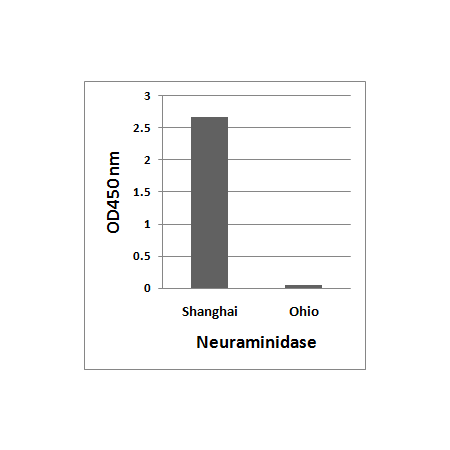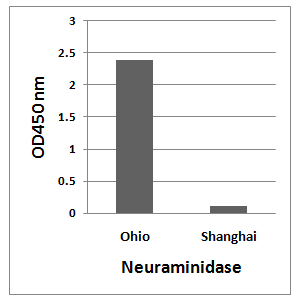Avian Influenza A H7N9 Neuraminidase Antibody - N-terminal
Katalog-Nummer OAPB01907
Size : 0.1mg
Marke : Aviva Systems Biology
| Datasheets/Manuals | Printable datasheet for Avian Influenza A H7N9 Neuraminidase Antibody - N-terminal (OAPB01907) (OAPB01907) |
|---|
| Predicted Species Reactivity | Influenza A Virus|Virus |
|---|---|
| Product Format | Liquid. Avian Influenza A H7N9 Neuraminidase Antibody is supplied in PBS containing 0.02% sodium azide. |
| Clonality | Polyclonal |
| Isotype | IgG |
| Host | Rabbit |
| Conjugation | Unconjugated |
| Application | ELISA |
| Reconstitution and Storage | Store at 4C for three months and -20, stable for up to one year. |
| Immunogen | Avian Influenza A H7N9 Neuraminidase antibody was raised against a synthetic peptide corresponding to 11 amino acids near the amino terminus of the H7N9 [Influenza A virus (A/Shanghai/02/2013(H7N9))] Neuraminidase protein. The immunogen is located within amino acids 50 - 100 of Avian Influenza A H7N9 Neuraminidase. |
| Purification | Affinity Purified |
| Concentration | 1 mg/ml |
| Specificity | virus |
| Application Info | ELISA: 1 ug/mL |
| Gene Symbol | NA |
|---|---|
| Protein Name | Neuraminidase|neuraminidase [Influenza A virus (A/Shanghai/02/2013(H7N9))] |
| Description of Target | Catalyzes the removal of terminal sialic acid residues from viral and cellular glycoconjugates. Cleaves off the terminal sialic acids on the glycosylated HA during virus budding to facilitate virus release. Additionally helps virus spread through the circulation by further removing sialic acids from the cell surface. These cleavages prevent self-aggregation and ensure the efficient spread of the progeny virus from cell to cell. Otherwise, infection would be limited to one round of replication. Described as a receptor-destroying enzyme because it cleaves a terminal sialic acid from the cellular receptors. May facilitate viral invasion of the upper airways by cleaving the sialic acid moities on the mucin of the airway epithelial cells. Likely to plays a role in the budding process through its association with lipid rafts during intracellular transport. May additionally display a raft-association independent effect on budding. Plays a role in the determination of host range restriction on replication and virulence. Sialidase activity in late endosome/lysosome traffic seems to enhance virus replication. |
| Protein Accession # | https://www.ncbi.nlm.nih.gov/protein/AGL44440 |





